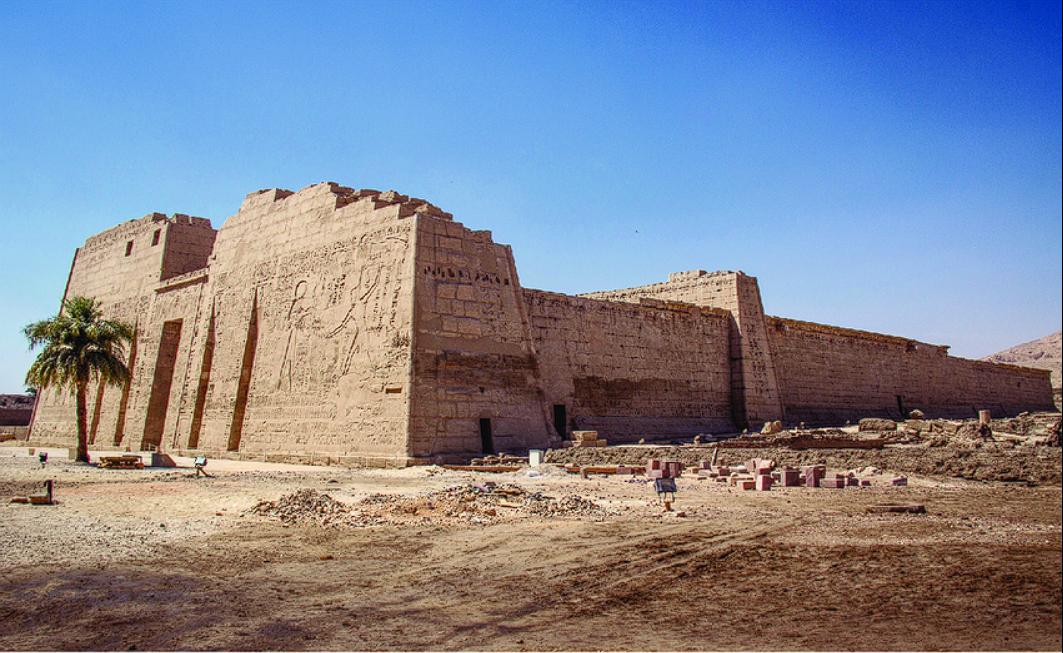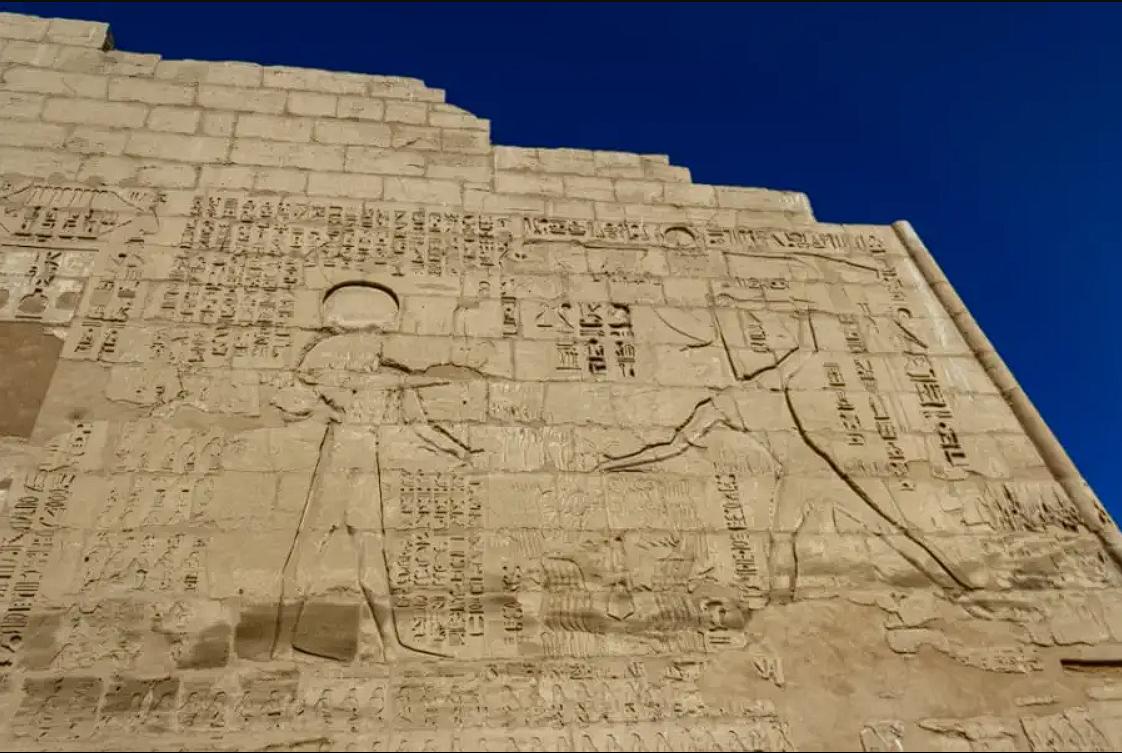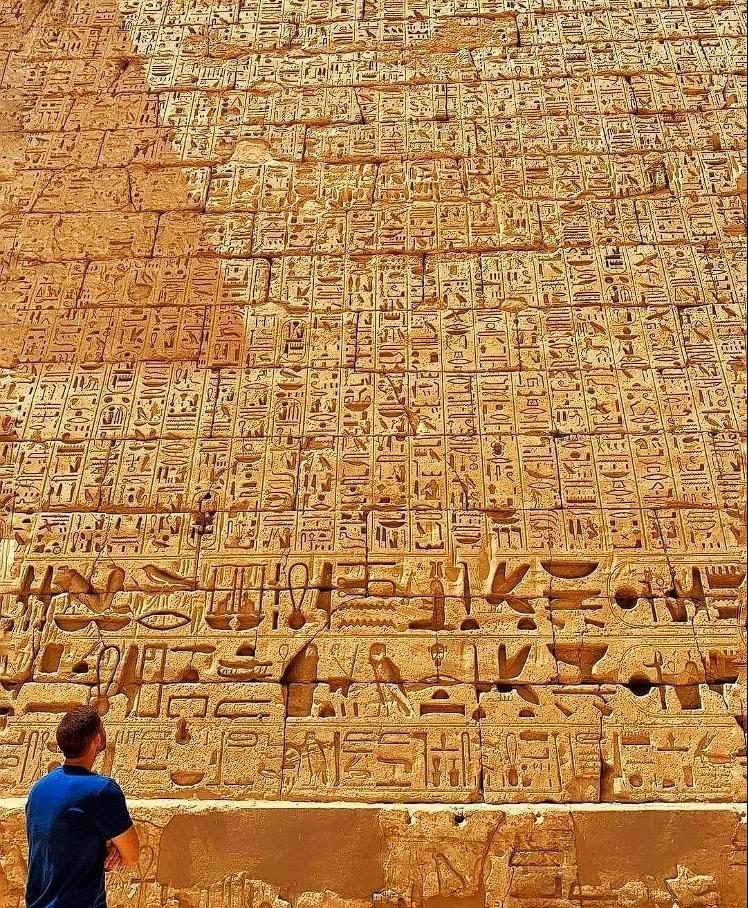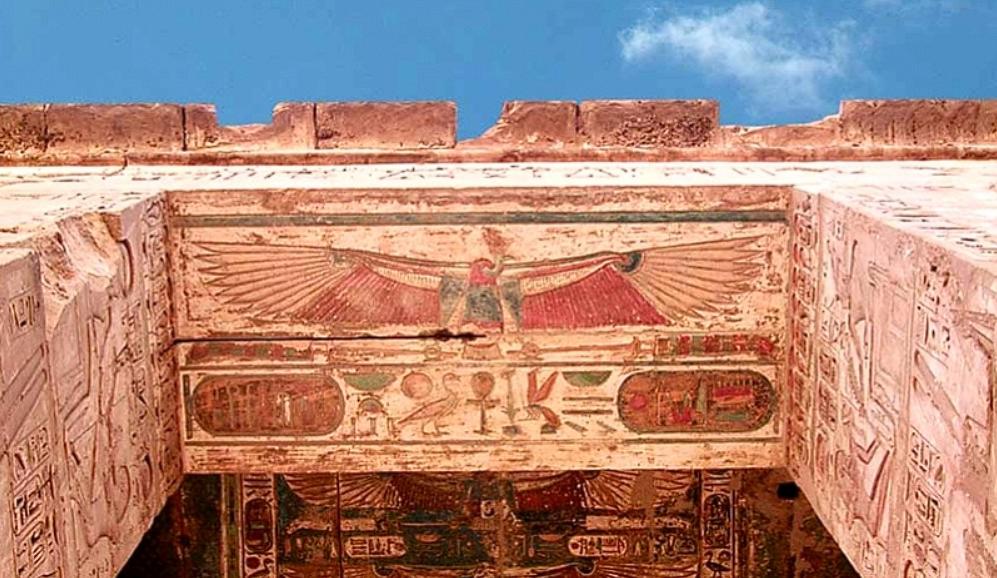“The imposing walls of the Temple of Ramesses III at Medinet Habu stand as a monumental chronicle etched in hieroglyphs, offering a compelling glimpse into a pivotal and turbulent era in the history of ancient Egypt. Constructed during the reign of Ramesses III (1186–1156 BC), this temple on the West Bank of Luxor serves as more than just a religious edifice; it is a vivid historical record of a powerful pharaoh’s efforts to preserve a declining empire against formidable external and internal pressures, ultimately foreshadowing the eventual collapse of one of the ancient world’s most dominant civilizations.”
Ramesses III: A Warrior Pharaoh in a Time of Upheaval
- A Temple as Historical Record:
- The Temple of Ramesses III at Medinet Habu transcends its religious function, serving as a comprehensive historical archive inscribed in hieroglyphs and elaborate reliefs. These visual and textual narratives document the reign of Ramesses III, particularly his military campaigns and his role as a defender of Egypt.
- This monumental temple stands as a powerful testament to the Egyptian practice of intertwining religious devotion with historical commemoration, ensuring that the pharaoh’s deeds and the challenges of his time were recorded for posterity.
- The Late Bronze Age Crisis:
- The reign of Ramesses III unfolded against the backdrop of the late Bronze Age collapse, a period of widespread upheaval and societal transformation across the ancient Near East. The once-dominant Egyptian Empire faced significant challenges, with its established trade networks disrupted and its borders increasingly threatened.
- This context of regional instability underscores the immense pressures that Ramesses III faced as he sought to maintain Egypt’s territorial integrity and its standing as a major power.
- Military Triumphs Against Formidable Foes:
- Despite the empire’s gradual decline, Ramesses III achieved notable military successes against a series of formidable enemies. The hieroglyphs and reliefs at Medinet Habu proudly depict his victories over the Libyans, the enigmatic Sea Peoples, and the Nubians, showcasing his strategic prowess and the strength of the Egyptian military under his command.
- These well-documented military campaigns highlight Ramesses III’s efforts to secure Egypt’s borders and project an image of strength and stability during a period of increasing vulnerability.

A Fleeting Stability: Ramesses III’s Legacy and the Inevitable Decline
- A Temporary Bulwark:
- While the Egyptian Empire was undeniably showing signs of decline during the late Bronze Age, Ramesses III’s determined efforts and military victories provided a period of relative stability for the region. His actions, as recorded at Medinet Habu, suggest a conscious effort to stem the tide of decline and preserve Egypt’s influence.
- This temporary respite, achieved through significant military exertion, underscores the resilience of the Egyptian state and the effectiveness of Ramesses III’s leadership in the face of mounting pressures.
- Political Statements in Stone:
- The inscriptions and reliefs at Medinet Habu are not merely objective historical records; they also served as powerful political statements. They emphatically emphasize Ramesses III’s role as the divinely appointed protector of Egypt, a leader who successfully defended the land from chaos and foreign invasion.
- This carefully constructed narrative aimed to legitimize his rule and reinforce the traditional image of the pharaoh as the guarantor of Egypt’s safety and prosperity during a time of significant anxiety and uncertainty.
- The Inexorable Slide:
- Despite Ramesses III’s efforts, the underlying factors contributing to the Egyptian Empire’s decline persisted. By the reign of Ramesses VI (1145–1137 BC), the empire’s influence had significantly waned, and its territorial control was no longer secure.
- This eventual collapse highlights the complex interplay of long-term internal and external pressures that ultimately proved too formidable for even a strong ruler like Ramesses III to fully overcome.

The Collapse of an Empire: Internal Strife, External Pressures, and Economic Woes
- A Multifaceted Decline:
- The reasons for the Egyptian Empire’s collapse during the period following Ramesses III are debated by historians, but it is clear that a confluence of factors contributed to its demise. Internal strife, including political instability and power struggles, weakened the central authority of the pharaoh.
- This internal fragmentation made Egypt more vulnerable to external threats and hampered its ability to effectively manage its resources and territories.
- The Weight of External Invasions:
- The sustained pressure from external invasions, including the continued threat of the Libyans and potentially the lingering impact of the Sea Peoples, further strained the empire’s resources and military capabilities. Defending Egypt’s borders required significant investment and manpower, diverting resources from other critical areas.
- These external threats, often occurring in waves, eroded Egypt’s territorial control and disrupted its economic stability.
- Economic Pressures and Resource Depletion:
- Economic pressures, potentially including resource depletion, disruptions in trade routes, and the costs associated with prolonged military campaigns, also played a significant role in the empire’s decline. A weakened economy further exacerbated internal tensions and limited the pharaoh’s ability to maintain control.
- This economic instability created a vicious cycle, further weakening the empire and making it more susceptible to both internal and external challenges.

A Legacy in Ruins: The Enduring Message of Medinet Habu
- A Poignant Reminder:
- The walls of Medinet Habu, with their vivid hieroglyphic inscriptions detailing Ramesses III’s triumphs and the context of a declining empire, remain a poignant reminder of both the resilience and the eventual fall of one of the world’s greatest ancient civilizations.
- This monumental temple serves as a powerful visual and textual testament to the cyclical nature of empires, highlighting the forces that can lead to both periods of strength and eventual decline.
- Echoes of a Lost Era:
- The stories etched in stone at Medinet Habu offer invaluable insights into the complexities of ancient Egyptian history during a transformative period. They provide a glimpse into the challenges faced by a powerful empire as it grappled with internal and external pressures.
- These echoes from a lost era continue to fascinate historians and archaeologists, providing crucial evidence for understanding the dynamics of ancient civilizations and the factors that contributed to their rise and fall.
- A Lesson in History:
- The narrative preserved at Medinet Habu serves as a powerful lesson in history, illustrating the interconnectedness of political stability, military strength, economic prosperity, and external pressures in the longevity of empires. The story of Ramesses III and the subsequent decline of Egypt offers valuable insights into the forces that shape human civilizations.
Conclusion:
“The hieroglyphic inscriptions adorning the walls of the Temple of Ramesses III at Medinet Habu offer a compelling and multifaceted narrative of ancient Egypt during a period of profound transition. They chronicle the valiant efforts of a warrior pharaoh to defend a declining empire against formidable foes, providing a fleeting moment of stability amidst widespread upheaval. However, these very walls also foreshadow the inevitable collapse of the Egyptian Empire, a consequence of internal strife, external invasions, and economic pressures. Medinet Habu stands as a poignant and enduring reminder of the resilience and eventual fall of one of the ancient world’s most magnificent civilizations, its hieroglyphs whispering tales of power, struggle, and the inexorable passage of time.”

CÁC TIN KHÁC
Mary Walton: The Forgotten Inventor Who Helped Clean Up America’s Cities
Tomb of Queen Nefertari in the Valley of the Queens, Egypt
Discover the Hypostyle Hall of the Temple of Hathor at Dendera
Venus de Losange: Unveiling the Mystery of a 20,000-Year-Old Paleolithic Icon